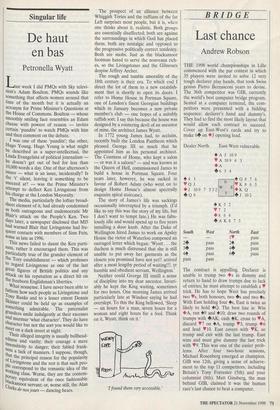BRIDGE
Last chance
Andrew Robson
THE 1998 world championships in Lille commenced with the par contest in which 35 players were invited to solve 12 very tough declarer play hands, that took Swiss genius Pietro Bemasconi years to devise. The 36th competitor was GIB, currently the world's best computer bridge program. Seated at a computer terminal, the com- petitors were presented with a bidding sequence: declarer's hand and dummy's. They had to find the most likely layout that would allow each contract to succeed. Cover up East-West's cards and try to make 6+ on •J opening lead. • Dealer North East-West vulnerable 4A J 109
• A 109 4 3 • A 6 5 4 44 3 • Q J
• J 109 7 532 +Q9
N W E
4 Q 8 7 6
• K 8 6 5 • K Q J 102
4 K 5 2 V7 2 • 8 6 4 44 A K 8 7 3 South 2+ 3+ 44 pass West pass pass pass pass North 1V 24 4+ 6+ East pass pass pass pass The contract is appalling. Declarer is unable to trump two Vs in dummy and return to hand to draw trumps due to lack of entries; he must attempt to establish a trick. He has to hope West has precisely two Vs, both honours, two 4's and two 4s. With East holding four 4s, East is twice as likely to hold 4Q. The best line is: Win *A, run 49 and 410; draw two rounds of trumps with +AK; cash 4K, cross to VA, discard V7 on 4A, trump V3, trump *6 and lead V10. East covers with VK, so trump and exit with the last trump. East wins and must give dummy the last trick with V9. This was one of the easier prob- lems. After four two-hour sessions, Michael Rosenberg emerged as champion. GIB was 12th, giving a sense of achieve- ment to the top 11 competitors, including Britain's Tony Forrester (5th) and your columnist (8th). Matt Ginsberg, the man behind GIB, claimed it was the human race's last chance to beat a computer.


















































































 Previous page
Previous page